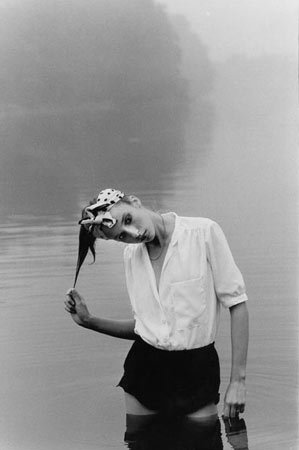AFP
Jul 24, 2009
Fighting to be fashionable in communist East Germany
AFP
Jul 24, 2009
BERLIN, July 24, 2009 (AFP) - In 1980s communist East Germany, nearly all clothing available was mass-produced and functional rather than fashionable, leaving little room for individuality and self-expression.
 "In Grenzen Frei"' at the Kunstgewerbemuseum - Ute Mahler: Summer Fashion 1979 for "Sibylle" - Photo: Ute Mahler |
But as a new exhibition in Berlin shows, there was a vibrant underground that offered not only fashion alternatives but also a subtle way to rebel against the oppressive regime of the German Democratic Republic (DGR).
And it was one which authorities could do little to counter.
For organisers of "In Grenzen Frei" ("Free Inside the Borders") at the capital's Kunstgewerbemuseum (Museum of Decorative Arts), this clothes-as-dissent was a small but valuable contribution towards the peaceful revolution that tore down the Berlin Wall 20 years ago this November.
"The fashion subculture liberated itself before the Berlin Wall made freedom a reality," a museum statement said.
"For them the GDR only continued to exist to a limited extent."
One of the curators, Grit Seymour, recalls the period with horror. A student thrown out of her East Berlin fashion college "for political reasons" in 1986, she went on to become a successful international designer.
"There was absolutely no way on earth that we could walk around dressed in the stuff from the shops," she says.
People often got ideas from "Sybille", a GDR fashion magazine with much more interesting outfits but ones not available to the masses -- as either way too expensive or never made it past the Iron Curtain.
The magazine, however, included patterns and instructions on how to sew the outfits -- if you managed to find the materials. Photos from "Sybille" form part of the exhibition and replicas of patterns are on sale in the gift shop.
"Sybille was all about dreams, peddling dreams that could not really come true ... There were 200,000 copies printed but each magazine went through at least 10 pairs of hands," Seymour says.
There were also shops called Exquisit offering clothes by Paris-based designers like Norwegian Per Spook and Frenchman Daniel Hechter, but they didn't come cheap.
"A pair of leather trousers, for example, that I bought myself cost 1,100 marks, which was considerably more than the monthly income of a normal worker," Seymour says.
Fashions from the West slipped through in other ways, and were seen as a glimpse into an exciting new world.
-- It was resistance through refusal --
---------------------------------------
Writer Alexander Kuehne, for example, recalls being amazed by an article in a West German magazine he got hold of about "London's New Romantic Scene".
"They all had these pale, made-up faces ... The pictures showed an intense decadence, a feeling that was breaking out in me more and more," Kuehne says in a book accompanying the exhibition.
Inspired, Kuehne and his friends searched everywhere for clothes and accessories to recreate the look of "new romantic" bands such as Adam and the Ants or Spandau Ballet, taking eye patches from first aid kits and holding illicit happenings.
"Gelled hair, evening dresses and duffel coats with fur collars took over, for one evening, 500 square meters (5,400 square feet) of this deadly boring republic," he says of one particular night.
There were even secret, avant-garde fashion shows organised by groups that sprang up with names like "Allerleirauh" ("All Kinds of Fur") and "Chic, Charmant und Dauerhaft" ("Chic, Charming and Enduring") or "Omelette Surprise".
Videos of these wild-looking evenings -- which were almost exclusively organised by and for women, with men present only as models or porters -- also feature in "In Grenzen Frei".
But the scene went beyond fashion, with dress doubling as statements of both freedom and subversion.
"I came from the punk scene and we had a much more confrontational way of dealing with the state, but suddenly I came across people who did things completely differently," says Henryk Gericke, one of the exhibition organisers.
"They just let the state get on with it, while we tried to break it. This was a form of resistance that was completely new to me, it was a form of resistance through refusal."
Gericke, who made a film about the GDR punk scene called "Too Much Future" -- as opposed to the Sex Pistols' "No Future" -- also holds that "just ignoring the state" helped bring down the system in 1989.
"I definitely believe that the punks made a lot of things possible that from the mid 80s onwards, other groups made use of. But they also pushed further the limits that we had opened," he says.
The exhibition runs to September 13.by Simon Sturdee
Copyright © 2024 AFP. All rights reserved. All information displayed in this section (dispatches, photographs, logos) are protected by intellectual property rights owned by Agence France-Presse. As a consequence you may not copy, reproduce, modify, transmit, publish, display or in any way commercially exploit any of the contents of this section without the prior written consent of Agence France-Presses.

























